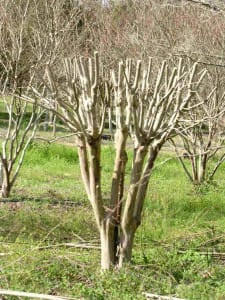Source(s): Stephen D Pettis
The Crape myrtle (Lagerstroemia indica) is one of the most commonly used flowering trees in landscaping today. It also has the dubious distinction among gardeners and horticulturists as the plant that gets butchered in the worst way by homeowners and property maintenance companies.

‘Crape murder’ is a term used to describe the horrific pruning that many unfortunate crapes must endure and it isn’t far off the mark. The plants do not seem to mind particularly, as they are actually stimulated by extreme pruning. But, to those of us who empathize with abused creatures, the sight of mutilated crape myrtles is hard to stomach.
Crape myrtles are trained by nurseries into two basic shapes: single-stemmed tree-form and multi-stemmed. To achieve these shapes, growers allow crapes to grow for a year in either containers or fields, and cut them down to the ground in the spring of the second year. Later that summer when the plant has coppiced or grown many stems from the original root system, the grower will choose the single best stem and train it into a single-stemmed tree-form tree or choose an odd number of the best stems (3 or 5 for example) for a multi-stemmed tree. These trees are then grown out to salable size and purchased by landscapers and homeowners.
Pruning crapes so that they retain the appropriate form is relatively simple. Prune the trees in the winter when dormant. For trees that are just the right height or shorter, simply prune off the old flower heads and seedpods. If the tree was perfect last year but the past summer’s growth made the plant too tall, remove just that growth. Always remove any suckers that have sprouted from the roots or lower trunk. The key is to not allow the trees to get so overgrown that extreme pruning is ever necessary.
Sometimes though, we may forget to do our yearly maintenance pruning or it may be we take over a property where the previous maintenance person did a lousy job and now a harsh pruning is necessary. In either case, the trees can be pruned in such a way as to minimize the aesthetic impact of the removal of sizable portions of the tree. Begin by identifying the main stems and remove any others that might have suckered from the roots. Next, prune out any branches that rub and any branches in the interior of the tree that have suckered. Then decide the height you wish the tree to become. Make cuts at the very top of each trunk to remove any growth above that height. The tree may look a little flat-topped, but you can make shaping cuts to make the canopy the shape you want. I prefer the very top to be a little flat and to taper the sides into a rounded shape. One might describe it as umbrella shaped(see picture).
Resource(s):
Center Publication Number: 112
- Herbicide Damaged Plants - September 24, 2013
- IPM in the Garden - September 24, 2013
- Leylands Get Really Big - September 24, 2013